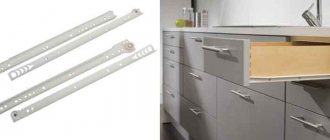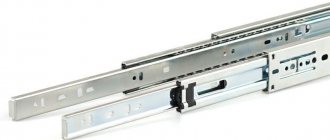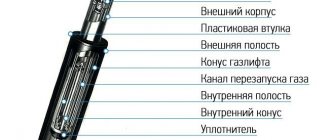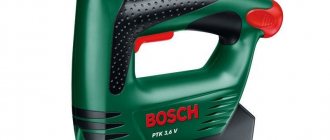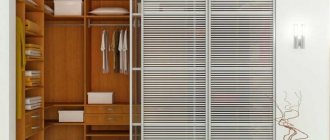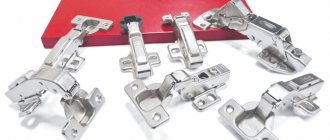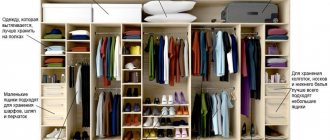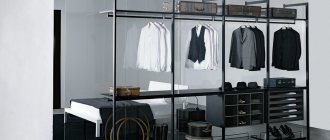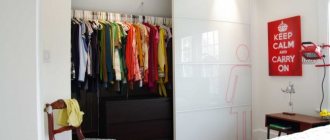When assembling furniture, craftsmen often have to deal with the need to select and secure the guides along which the drawers move. At first glance, this process is not the most complicated and requires attentiveness and accuracy, since the durability of the structure and the ease of its operation depend on the quality of the parts and the installation performed.
Installing drawer guides
Varieties
Thanks to roller structures, it has become much more convenient to use not only storage systems, but also furniture in everyday life. And the ease of moving objects makes it easy to change the decor in the room without damaging the floor coverings.
Furniture supports
It is quite natural that the variety of furnishings implies the use of different types of rollers. Based on the type of construction, movable supports are divided into three types:
- Swivel - allow you to easily maneuver when moving furniture in a small room. It’s convenient when objects can easily be rotated 360 degrees in one place. Used for installation on office and home furniture (tables, cabinets, poufs);
- Fixed (straight motion) - allow you to quickly move furniture in spacious rooms without the need to unfold it (pull-out parts of the sofa). Reliable fastenings can withstand significant loads, but are not intended for constant movement of objects;
- Rollers with brake - thanks to a special device, you can block the wheel and the swivel unit.
To prevent furniture casters from quickly breaking down, it is important to choose the right method of attaching the casters. Manufacturers offer several ways to fix them. The most common are:
- U-shaped profile - used when installing a support on the end of a chipboard;
- Platform is the most popular type;
- Threaded pin is used in office chair casters;
- Mortise - a suitable option when making furniture drawers.
Manufacturers use a variety of materials to produce wheels. The traditional ones are metal (steel or aluminum), plastic (reinforced). Furniture casters are most often covered with a special outer rim to prevent damage to the floor covering when moving objects. A protective layer is made from rubber, Teflon or other high-strength polymer materials.
Furniture wheels are available with bearings and hinges. To give mobility to large-sized furniture, bearing rollers are better suited, characterized by reliability and quiet operation. And articulated models are better able to ensure smooth movement of objects and easy turns. The roller guides are partially retractable, allow the drawers to be used silently and are made of steel.
With brake
Rotary
Fixed
Rollers for sliding systems
Wheels are part of the fittings of sliding wardrobes and determine the ease of closing/opening the doors and smooth operation. To prevent dust from getting inside the wheel mechanism during operation, sealed bearings are used. Aluminum bearings ensure silent movement of the rollers, while steel bearings have a long service life.
In the production of cabinets, two opening systems are used: bottom-support and hanging.
- The most universal is considered to be the bottom support one, since such a design can support doors of any weight and purpose. The main load falls on the rollers moving along the lower guide. And the top guide is designed to fix the door;
- In suspended systems, the support roller carriage moves along the upper rail guide. Interior doors and partitions are equipped with similar structures.
Many companies produce kits for compartment doors and pay great attention to the quality of parts. When choosing products, it is worth taking into account the developments of individual manufacturers: the German company Raumplus makes lower rollers from high-strength polyamide, which does not delaminate, and the bearing does not need lubrication. The Polish brand Indeco equips the lower rollers with a device that prevents the web from coming off the guide.
Installation of guides
If we are not talking about replacing broken devices, the choice of a guide system is made at the design stage, since its parameters must be taken into account. When installing the mechanism, it is necessary to correctly calculate the attachment points. Do not tighten the screws completely. It is recommended to bait them all first, and then tighten them all the way. Otherwise, the entire system may become distorted, causing it to become incapacitated.
Replacing a worn roller mechanism with a similar one
Situations where rollers wear out and drawers become difficult to pull out and close are common. It is with roller fittings that problems are most often possible.
Photo of a worn-out roller
The easiest way to fix the problem is to replace the device with a new one. If you want to save money, you can take the same roller guides, fortunately they cost no more than 100 rubles.
- Damaged parts must be removed. It's not at all difficult to do this. You don't even have to have a power tool at home.
To begin, remove the guides - It is necessary to open the packaging and check the functionality of the new set of guides.
Inspection of new guides - You can start fixing the fittings. The existing screw holes are used for fastening. We should not forget about the silicone gaskets that are installed between the metal parts and the inner wall of the furniture.
Silicone gaskets must be used - As noted above, it is important not to forget about the additional screw in the upper part of the bar (perhaps its absence was the cause of the breakdown).
Don't forget to tighten the extra screw - The new fittings do their job perfectly.
Checking the functionality of new fittings
Video - Causes of breakdowns of roller guides
Replacing roller guides on dresser drawers with telescopic ones
If the roller fittings break down, it is not necessary to install the exact same set. In order not to step on the same rake, it is recommended to purchase modern telescopic models from a trusted manufacturer.
Table. What will be needed to carry out the work?
| Name | Illustration |
| Ball guides | |
| Self-tapping screws | |
| Screwdriver, ruler and pencil |
The sequence of actions is given below.
- Removing faulty guides. This is not difficult to do, armed with a screwdriver or a simple screwdriver.
First, the old guides need to be dismantled - To replace broken mechanisms, German fittings will be installed, the service life of which usually exceeds the service life of the furniture itself.
New German fittings - After dismantling the roller mechanisms, an important step must be taken - marking for installation of the guides. Unlike models with rollers, one part of which was fixed to the bottom of the drawer, and the second - at its level to the wall of the chest of drawers, telescopic strips are mounted in the center. It’s easy to determine the center line on a box - just divide its height in half. If the height of the side wall of the box is 96 mm, 48 mm are measured at two points and a line is drawn. The line is applied on both sides of the box.
Markings are applied for mounting guides - It is a little more difficult to apply markings for fastening on the chest of drawers - you need to take into account the gap from the top point of the drawer front to the dresser lid (4 mm) and the height of the edge of the front protruding beyond the dimensions of the drawer (20 mm). By adding these values with the already determined half of the height of the box itself, we get the value that needs to be measured to draw a horizontal line (from the lid down) - 72 mm.
Marked chest walls - On the other side, the same segment is drawn.
- If a small error occurs in the calculations, there is no reason to be especially upset. The holes for fastening the guides are made in such a way as to provide some free movement of the slats during installation. They can be slightly shifted in height in one direction or another.
Holes ensure free movement of the bar - The guide is disassembled for installation. To do this, on the back side you need to press the lever, which allows you to remove the guide segment. The removed part of the fittings will be attached directly to the drawer, the remaining mechanism will be attached to the inner wall of the chest of drawers.
The guide is disassembled - The separated segment of the telescopic device is installed on the box (it should rest against the facade). Using self-tapping screws (16 mm), the strip is attached to the drawer at three points (the fasteners are installed in holes, the size of which allows you to adjust the vertical position of the guide).
The fittings segment must rest against the façade - The main part of the guide is fixed to the inside side of the chest of drawers. When installing it, it is necessary to take into account the thickness of the facade (recess the bar to this distance). In our case, the thickness of the facade is 16 mm. In addition, the installation of the guide must be carried out with an indentation of 2 mm. As a result, the bar is installed at a distance of 18 mm from the edge of the chest of drawers. This should not always be done. In our case, the facade is recessed, but the overhead installation method is most often used.
The main part of the guide is fixed on the inside - To insert a drawer with guides into the chest of drawers, you need to align them and wait for a click confirming the mechanism is activated.
A drawer with guides is inserted - If desired, it is possible to install a closer that allows drawers to close smoothly and without effort. The universal device can be fixed on any side of the chest of drawers. For fastening you will need two self-tapping screws attached to its edges.
Additionally, you can install a door closer
Important! For better functioning of the closer, the rubber clips should be removed from the guides. The structure is assembled and ready for use.
Problems may arise when using the system. As a rule, they arise due to incorrect installation (you can try to correct the situation by adjusting the fasteners), exceeding the load capacity of the mechanism, or poor quality components. But in general, modern guides, when used correctly, serve without fail for a long time.
Parameters and sizes
The functionality and ability of the rollers to bear the load is determined by several factors: the material of manufacture, options for fastening the wheel and support, and dimensions. To simplify the selection of wheels, take into account the following indicators:
- Load capacity – naturally, small diameter models can support less weight than large wheels. We can conditionally distinguish the following correspondences: roller diameter 30 mm - 15 kg, 50 mm - from 25 to 40 kg, 60-75 mm - from 50 to 100 kg, 160 mm - 135 kg;
- The diameter of the rollers/height of the wheel support ranges from 15-195 mm;
- Roller systems are equipped with wheels and balls. The minimum width of a narrow wheel is 13 mm, a wide one is 42-47 mm;
- Material – steel and aluminum are used to produce reliable supports; wood is chosen to create exclusive products;
- Design and color are determined by the style of the interior. The fitting element (roller guide) may be white or brown. For interiors in the style of minimalism and high-tech, chrome-plated support models are suitable. Office or computer chairs are equipped with interesting casters of various shades.
Stationary rollers can be fixed with square or rectangular plates. On rotary models, mounting plates come in square or rectangular shapes. The mortise wheel may have two plates (in different planes) for fastening.
Sliding systems
Taking into account that the main load in structures falls on the fittings, special attention is paid to its quality and reliability. Traditionally, durable plastic is used to make wheels. To create a protective rim, the following are used: rubber, Teflon, tarmonide (hardened composite), steel.
If the door leaves have a significant mass, then rollers with metal bushings are installed. A door leaf weighing up to 60 kg is equipped with two pairs of rollers; a heavy leaf (but not more than 100 kg) is equipped with four pairs. On average, the roller design must withstand 70 thousand openings.
Load calculation
It is very important to calculate the future load on wheel accessories in advance, so as not to damage the wheels during use. From this it can be seen that to carry out the calculation the following factors must be taken into account:
- The weight of a piece of furniture - as a rule, it is indicated in the accompanying documents;
- Estimated load - if you plan to place any things on the furniture (or inside it) on a permanent basis, then the weight of the future permanent load must be added to the weight of the furniture itself;
- Additional non-constant load - this applies to objects that will be on the furniture object, but their weight may change from time to time (for example, an array of books on a shelf).
Thus, knowing the potential load, it will be very easy to select the appropriate movable supports.
Criterias of choice
Most often, manufacturers make all furnishings with conventional supports. Any attempts to rearrange bulky cabinets or sofas can lead to damage to the floor covering. Also, many apartment owners are familiar with the situation when objects cannot be placed near the doorway, otherwise the door cannot be opened wide enough. Thanks to the rollers, you can experiment with arranging things as many times as you like or install a non-standard and convenient door.
For furniture
The furnishings are a component of the interior and have important practical applications. Selecting the appropriate rollers ensures the safety, reliability and durability of the products:
- The main criterion for fittings is reliability. Therefore, it is advisable to know exactly the mass of additional load on the furniture. Indeed, in the case of a soft corner, the additional weight can be several times the weight of the furniture. This is also important when purchasing office chairs, since they can be used by very large and heavy people. Choosing the appropriate fittings will not only ensure safe operation, but will also increase the service life of the furniture;
- Quality of component materials. The best option is if the roller support for heavy furniture is made of metal. Light objects (tables) can be equipped with plastic products;
- The design features of the rollers should ensure their reliable fixation to the furniture;
- It is advisable to install supports with the ability to rotate on small objects in order to increase the mobility of things, especially in small rooms. This also matters for furniture that is usually rotated - coffee tables, cabinets with equipment.
- Depending on the floor covering in the home, the working surface of the wheels is selected. In rooms with hard floors (tiles, laminate, parquet), it is better to use rubber rollers that gently touch the surface and do not leave marks. For rooms with floor decor (carpets, rugs), wheels with a metal coating of large diameter are suitable;
- It is advisable to install supports with soft coverings on office/work chairs, since the furniture is moved on a small area of the floor and the load on the surface will be increased;
- If it is periodically necessary to fix the furniture in one position, then wheels with a stopper are installed (on at least two casters). When it is necessary to ensure absolute stability of an object (table, stand), then all four wheels with stoppers are installed. The wheel is fixed by pressing a button located on the bracket. To release the brake, you must press the button again.
When purchasing any design, you need to make sure that the rollers rotate smoothly, without squeaks.
For sliding systems
When arranging storage systems and sliding doors, certain requirements are imposed on the fittings. Therefore, when choosing components, pay attention to the following points:
- Support rollers made of cheap plastic are inexpensive, but have low strength, which leads to damage under impact loads and low service life;
- The ideal option is rollers in which the wheels are made of metal and covered with Teflon protection;
- Sliding systems with top suspension are highly reliable, since the running carriages are securely connected to the curtains. Such doors can be installed in children's rooms. Installation of the system is more complicated than the bottom-support version, because the rollers are adjusted in two planes;
- When arranging massive doors of a large cabinet, it is recommended to install a combined opening system (supports are fixed at the bottom and top). This design requires high-quality installation and adjustment of all parts, but guarantees strength and reliability.
Furniture casters can be called a universal solution for moving objects. The mobility of things makes it easy to choose options for their convenient location, without the help of neighbors or movers. And thanks to the variety of materials and designs, wheels can become a real decoration of products.
Material of manufacture
Furniture casters are most often made of plastic or polyurethane. The advantage of the first option is its low cost, and therefore the opportunity to significantly save the family budget. It is used for oversized, lightweight furniture at a budget price. Meanwhile, plastic has many negative characteristics that can lead to product breakage, injury, and scratched floors. These wheels:
- unstable;
- poorly maneuverable;
- they have no flexibility of movement.
The rubber roller is superior to its plastic counterpart in strength and wear resistance, moves silently, and does not leave marks on the floor covering.
In rubber models, only the wheel that is in contact with the surface is usually coated with polyurethane, and the load rim is made of cast iron or nylon. A roll-out roller with a rubberized wheel is often installed on office, hairdressing and any other chairs, due to which they are characterized by ease of movement and ease of movement. Such models are not afraid of high temperatures and are designed for high loads.
Plastic
Polyurethane
Rubber
With door closer
Guides for drawers with closers have a similar structure to the previous version. The closer ensures that the drawer is picked up in a certain position and smoothly closes automatically.
Advantages: smooth and quiet operation, reliability and ease of use, ability to withstand significant loads.
Surface mounting
Installing such guides is the most difficult. The process takes a long time and requires significant effort.
Pros: ease of use, high reliability and quality, smooth running and quiet operation.
Reverse acting
In this case, you need to lightly press the front of the drawer with your hand so that it begins to open. No handles or recesses are needed, which only adds to the attractiveness of the furniture.
The downside is that it takes significant effort to push the drawer. In addition, it extends too sharply.
Instead of an epilogue
It is worth noting that most of the supports and rollers presented on the modern market are of Russian origin. At the same time, along with good quality, there is no sharp increase in their prices. However, you should purchase such accessories only in specialized stores, because analysis shows that in standard large construction supermarkets the selection of these products is very small. The main difference between Russian samples and foreign ones is that the latter foreign companies often provide an extended warranty.
